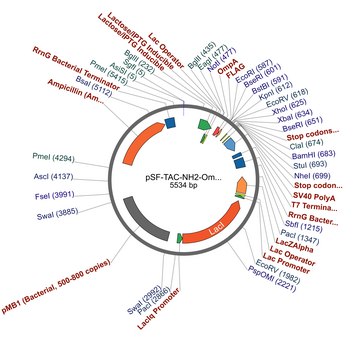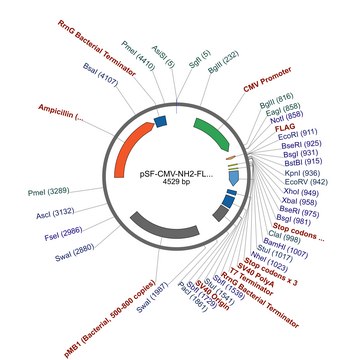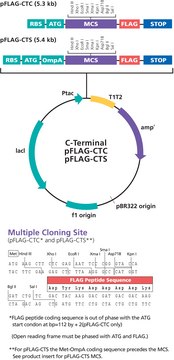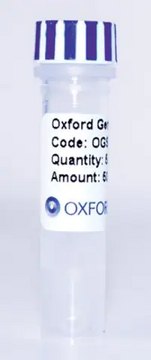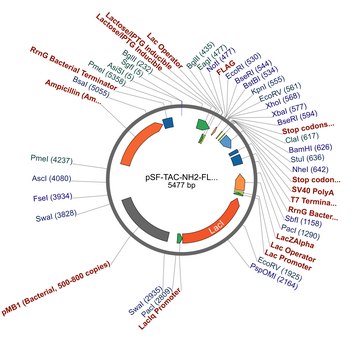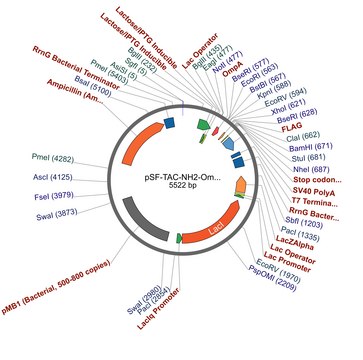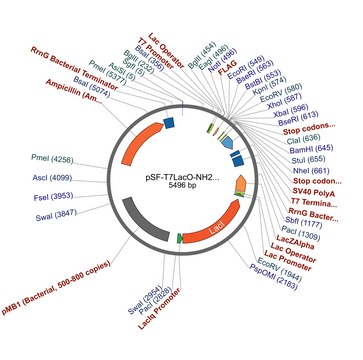E8158
pFLAG-ATS™ Expression Vector
Bacterial vector for periplasmic expression of N-terminal FLAG fusion proteins
Sign Into View Organizational & Contract Pricing
Select a Size
All Photos(2)
Select a Size
Change View
About This Item
UNSPSC Code:
12352200
Recommended Products
tag
FLAG® tagged
grade
Molecular Biology
form
buffered aqueous solution
shipped in
dry ice
storage temp.
−20°C
General description
The pFLAG-ATS™ Expression Vector is a 5.4 kb E. coli expression vector used for cloning and periplasmic expression of properly inserted open reading frame as an N-terminal FLAG fusion protein. The N-terminal FLAG® fusion protein may be detected using Monoclonal ANTI-FLAG M1, Catalog Number F3040, or Monoclonal ANTI-FLAG M2, Catalog Number F3165, or purified using ANTI-FLAG M1 Agarose Affinity Gel, Catalog Number A4596 or ANTI-FLAG M2 Affinity Gel, Catalog Number A2220.
The pFLAG-ATS-BAP Control Plasmid is a 6.8 kb E. coli plasmid used for efficient and controlled periplasmic expression of N-terminal FLAG-BAP fusion protein.
Vector Maps and Sequences
The pFLAG-ATS-BAP Control Plasmid is a 6.8 kb E. coli plasmid used for efficient and controlled periplasmic expression of N-terminal FLAG-BAP fusion protein.
Vector Maps and Sequences
Components
- pFLAG-ATS™ Expression Vector 10 μg ( E5769) is supplied as 0.5 mg/ml in 10 mM Tris-HCl (pH 8.0) with 1 mM EDTA
- pFLAG-ATS™-BAP Control Plasmid 1 μg (C9079) is supplied as 0.5 mg/ml in 10 mM Tris-HCl (pH 8.0) with 1 mM EDTA.
Legal Information
FLAG is a registered trademark of Merck KGaA, Darmstadt, Germany
pFLAG-ATS is a trademark of Sigma-Aldrich Co. LLC
Storage Class Code
10 - Combustible liquids
Regulatory Information
新产品
Choose from one of the most recent versions:
Certificates of Analysis (COA)
Lot/Batch Number
It looks like we've run into a problem, but you can still download Certificates of Analysis from our Documents section.
If you need assistance, please contact Customer Support.
Already Own This Product?
Find documentation for the products that you have recently purchased in the Document Library.
J L Gommerman et al.
Blood, 91(6), 1891-1900 (1998-04-16)
Steel factor (SLF), the ligand for the c-Kit receptor, protects hemopoietic progenitors and mast cells from apoptosis. We show here that protection of 32D-Kit cells or mast cells from apoptosis by SLF is abrogated through concurrent inhibition of Ca2+ influx.
S Davletova et al.
Journal of experimental botany, 52(355), 215-221 (2001-04-03)
A calmodulin like domain protein kinase (CPK) homologue was identified in alfalfa and termed MsCPK3. The full-length sequence of cDNA encoded a 535 amino acid polypeptide with a molecular weight of 60.2 kDa. The deduced amino acid sequence showed all
Miaoying Tian et al.
Plant physiology, 138(3), 1785-1793 (2005-06-28)
The plant apoplast forms a protease-rich environment in which proteases are integral components of the plant defense response. Plant pathogenic oomycetes, such as the potato (Solanum tuberosum) and tomato (Lycopersicon esculentum) pathogen Phytophthora infestans, secrete a diverse family of serine
Miaoying Tian et al.
BMC biochemistry, 6, 15-15 (2005-08-25)
Kazal-like serine protease inhibitors are defined by a conserved sequence motif. A typical Kazal domain contains six cysteine residues leading to three disulfide bonds with a 1-5/2-4/3-6 pattern. Most Kazal domains described so far belong to this class. However, a
P J Brown et al.
FEBS letters, 497(1), 31-38 (2001-05-30)
Micronemes are specialised organelles, found in all apicomplexan parasites, which secrete molecules that are essential for parasite attachment to and invasion of host cells. Regions of several microneme proteins have sequence similarity to the Apple domains (A-domains) of blood coagulation
Related Content
Bacterial Expression Vectors: tac Promoter System
Our team of scientists has experience in all areas of research including Life Science, Material Science, Chemical Synthesis, Chromatography, Analytical and many others.
Contact Technical Service